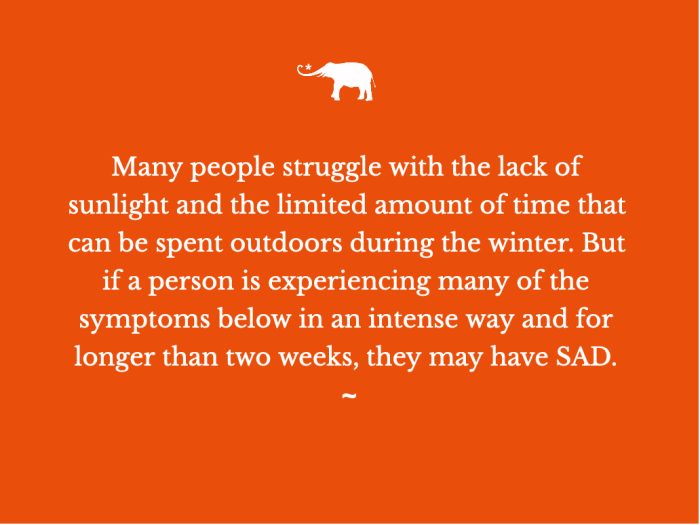Winter. The excitement of the holidays is over. The days are shorter. It gets dark before dinner is finished. It’s hard to get outside. There are so many dreary, overcast, no-sunshine-in-sight days as we wait for spring.
Many people find the weather and darkness of winter to be a difficult time of year. Even children can struggle with the changing of the seasons. But when sadness in winter becomes severe, the person may be suffering from seasonal affective disorder, or SAD.
What is Seasonal Affective Disorder?
Seasonal affective disorder is characterized by the following symptoms:
● Intense sadness
● Irritability
● Feelings of tiredness
● Decreased performance at work or school
● Lack of interest in previously enjoyed activities
● Change in appetite
● Lower self-esteem
● Feelings of loneliness or disappointment
● Isolating from friends and family
● Suicidal ideation
While SAD has all the same symptoms of major depressive disorder, the symptoms of SAD are only felt during certain months of the year. It is most common for people to experience SAD during the fall and winter months. However, it is possible for people to experience summer-pattern SAD that presents as the same symptoms but in spring and summer.
Many people struggle with the lack of sunlight and the limited amount of time that can be spent outdoors during the winter. But if a person is experiencing many of the symptoms above in an intense way and for longer than two weeks, they may have SAD.
Mild SAD may be cured simply by the arrival of spring. But severe SAD, left untreated, can become so debilitating that the person has trouble functioning.
What Causes Seasonal Affective Disorder?
While we don’t know the exact cause of seasonal affective disorder, it is likely related to the levels of serotonin and melatonin in our brains.(1) The lack of daylight can disrupt the balance of serotonin, which regulates moods, and melatonin, which regulates sleep.
How Does Seasonal Affective Disorder Differ In Adults and Children?
Seasonal affective disorder presents with the same symptoms in children as adults. One place that we may see symptoms in children that we don’t see in adults is at school. Children may have difficulty focusing in the classroom or may be acting out more often. It can be difficult to understand why children are acting this way, but it is important to consider a SAD diagnosis if the behaviors begin in the winter months or the parents have expressed other concerns.
Children are at a higher risk of developing seasonal affective disorder if:
● They live at a higher altitude or far from the equator, as those places experience more extreme shifts in weather and the length of daylight.
● Their family has a history of depression or mental illness.
● They are female as women are more likely to be affected than men.
● They have low levels of Vitamin D.
Recognizing the signs of depression in your child is crucial. Every child has bad days. We all know that sometimes it can be as simple as them not getting their favorite color plate at lunch or having to wear their coat to go out in the freezing weather. There can be so many intense emotions in their little bodies.
So it is important to look for patterns in your child’s behavior and changes to those patterns that are unusual.(3)You know your child best. Signs of sadness or any of the other symptoms that last longer than two weeks need to be addressed.
Most times a child will not know why they are feeling this way. They won’t know to reach out for help and may not even know how to put their feelings into words. However, they may comment that they feel like a character in a book or movie. Oftentimes, children will find it easier to draw how they are feeling instead of verbalizing it. Whatever way your child chooses to show you how they feel, be ready to see and listen.
How To Help Your Child
The easiest way to help your child is the same way that you would help them prevent any illness.
Help them practice healthy habits. Try to get outside in the sunshine if at all possible. Even if you can’t get outside, make sure they are getting at least one hour of exercise each day. Maintain a sleep routine that gives them enough hours of sleep every night. Keep them well hydrated and eating a balanced diet.(1)
Talk with your child often about how they are feeling. The more in tune you are with them, the quicker you will identify signs of SAD. Encourage your child to connect with their friends and other family members.
If you think that your child’s case is severe, it is important to consult your pediatrician. Your pediatrician should check to make sure that there is not some other physical reason why your child is tired or having changes in appetite.
If there are no other problems present, they may then suggest other methods of treatment, such as light therapy, antidepressants, cognitive behavioral therapy, or Vitamin D supplements. Light therapy is well studied in adults and has proven to be an effective form of treatment for SAD. While there is not as much research with children, preliminary studies have shown that light therapy can be helpful to children as well. Many factors, such as their age and the length and severity of their symptoms, will be considered as a treatment plan is formulated.
Oftentimes, SAD will get better in the spring as the days get longer. But it may return again in the fall or winter. So, it is important to have professionals in your corner to help you navigate getting your child healthy again and working to keep them healthy.
If you find that your child is prone to sadness in winter, it is best to be proactive each fall. Set up good routines and stick to them, even through the holidays. Keep them involved in activities they enjoy. Discuss with your pediatrician about proactively starting treatments each fall or winter to prevent your child’s SAD from worsening.
SAD is entirely manageable when you find what works for your child and your family. You got this!
References
- https://www.parents.com/health/mental/does-your-child-have-seasonal-affective-disorder/
- https://www.childrensmn.org/2020/01/16/seasonal-affective-disorder-what-parents-need-to-know-about-sad/
- https://childmind.org/article/seasonal-affective-disorder/
- Rosenthal NE, Carpenter CJ, James SP, Parry BL, Rogers SL, Wehr TA. Seasonal affective disorder in children and adolescents. Am J Psychiatry. 1986 Mar;143(3):356-8. doi: 10.1176/ajp.143.3.356. PMID: 3953872.
- https://www.mayoclinic.org/diseases-conditions/seasonal-affective-disorder/symptoms-causes/syc-20364651
- https://www.nimh.nih.gov/health/publications/seasonal-affective-disorder
 Share on bsky
Share on bsky





Read 1 comment and reply